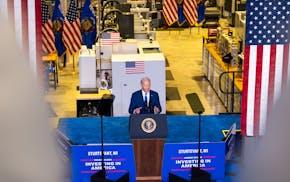Deepinder Singh, the boss at promising 75F of Mankato, reports that the energy-conservation firm that sells climate control systems to small commercial buildings has raised $650,000 from private investors in a first round of equity-capital raising.
Singh, 40, a computer scientist whose inspiration for the several-year-old firm came while trying to synchronize the room-to-room temperature in his drafty house, said the 21-person company plans to use the money to ramp up sales and marketing efforts. 75F has won several entrepreneurial and green-technology competitions and projects revenue of about $1.5 million this year.
Singh, married to a Mankato physician, has mostly financed the software-based company out of his own pocket, with revenue and proceeds from some of the awards.
Singh, a native of India, is an engaging guy who was working for a telecom company in Canada a decade ago while his wife was completing a medical fellowship across the river in Detroit. And I'll wager that he's the only Minnesota computer scientist/entrepreneur who ever has been a member of the Canadian national shooting team.
Singh's mother and grandfather were competitive Indian pistol shooters. Deepinder Singh, a national teen champion in 1992, chose to continue his college studies in engineering rather than join the Indian national team. He emigrated to Canada in 1998.
"I shot recreationally at the club level, but in 2001 decided to get a really nice match air pistol and I made the Canadian national shooting team in 2003 and remained on it until 2007," he recalled. "I represented Canada at multiple World Cups and medaled at the 2005 Championship of the Americas.
"Every time I pick up a pistol, I get super competitive and lose out on the fun. Even doing 'Ghostblasters' at the Mall of America. Ask my kids."
Farmers markets grow their own green
The "farmers market" economy is greening as spring slowly emerges.
Last week, the annual spring conference of the Minnesota Farmers' Market Association (MFMA), hosted nearly 200 people and organizations in Monticello. Topics ranged from "post-harvest handling for optimal produce" to "microloan" programs for small operators. Biologist Janssen Hang, a St. Olaf College graduate and the senior organizer of Hmong American Farmers Association, discussed that fast-growing segment of the Minnesota scene.
"As customers seek out more whole, unprocessed foods and niche brands, small growers and farmers markets stand to benefit," said Kirsten Bansen Weigle, manager of the Maple Grove Farmers Market and a director of the MFMA. "But only if they have the skills and resources to capture new customers."
To that end, an organization conceived in 1998 by a couple of dozen farmers market organizers has grown to represent 200-plus organizations around the state that focus on issues such as product labeling, state and local issues, marketing through "Minnesota Grown" promotions, cooperative marketing programs and acceptance of food-assistance benefits such as food stamps.
More information: www.mfma.org.
Warehouse District used to be for warehouses
The evolution of the Warehouse District, now often known as the North Loop, hits close to home for me.
I worked summers and school breaks there 45 years ago, loading and unloading trucks for a fabric company to help make tuition at DeLaSalle High School, and to salt money away in my Grain Belt/higher education fund.
Back then, the TractorWorks Building at 800 N. Washington Av. and an adjacent warehouse were grimy, barren places. We worked in T-shirts in the summer and heavy coats in the winter on the loading dock.
Recently, Lynette Dumalag of commercial real estate firm NTH informed me that the rents in the trendy TractorWorks building for some of the marketing-specialty food-and-technology firms approach the per-square rate on the lower floors in downtown's Capella Tower skyscraper.
Imagine that. Rent in the gentrified Warehouse District is "just like downtown," as we used to say. The "net rents" in both buildings, depending upon footprint size and floor, basically run from about $14 to $19 per square foot. That's before operating costs and taxes, which run higher in the downtown district.
Regardless, the TractorWorks building, which comes complete with Bar La Grassa and a health club, proves what you can witness as you go from strong-back laborer to no-heavy-lifting typist. The 105-year-old building sold for $55 million in 2015, double what it sold for in 2008.
Merchants Financial Group underscores banking's rebound
Winona-based Merchants Financial Group, 140 years old and owned by employees and hundreds of others in southeastern Minnesota, appears a proxy for the resurgent Minnesota community banking business.
Merchants, with 425 employees, earned $12.3 million last year, a shade less than its best year of 2012.
Commercial loan growth, a harbinger of future things, rose 14 percent over 2013 at the bank, which has deposits of $1.2 billion. CEO Rodney Nelson gave credit to hardworking employees and loyal, expanding customers.
Minnesota banks outperformed analysts' profitability expectations last year, according to the Minneapolis Federal Reserve Bank. Loan growth, an indicator of future profits, soared 6.6 percent last year. That was well above the 3.1 percent growth seen in 2013 and the median of just over 4 percent since 2000. Feldman lifted his forecast for 2015 loan growth to a range of 5.6 percent to 9.6 percent.
Twin Cities is in Big 10 of bartending trade
This just in from CareerBuilder, the labor-market intelligence gatherer: The Twin Cities area ranks No. 9 in the country on the ratio of bartenders per 1,000 residents, at 2.6!
We're better than Providence, R.I., and Seattle-Tacoma, Wash., but behind, you guessed it, beer-swilling Milwaukee.
The two cities with the largest tourism-related industries, lead the country. They are Las Vegas at 5.5 and New Orleans, 3.4. CareerBuilder tells us that oil-boom states North Dakota and Montana, boast the biggest tender-to-population ratio for states, at 5.2 each.
Beer, booms and busts always are bedmates.
There are nearly 580,000 bartenders in the U.S., which CareerBuilder says makes the national average about 1.8 bartenders per 1,000 Americans. More proof that this is a great country.
Tiger Woods to be lone player on negotiating committee with Saudis

